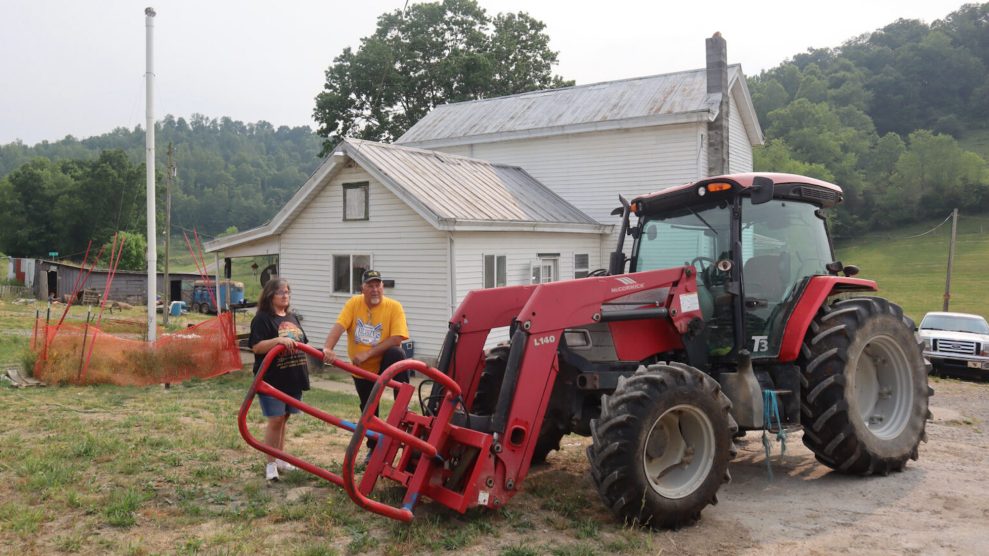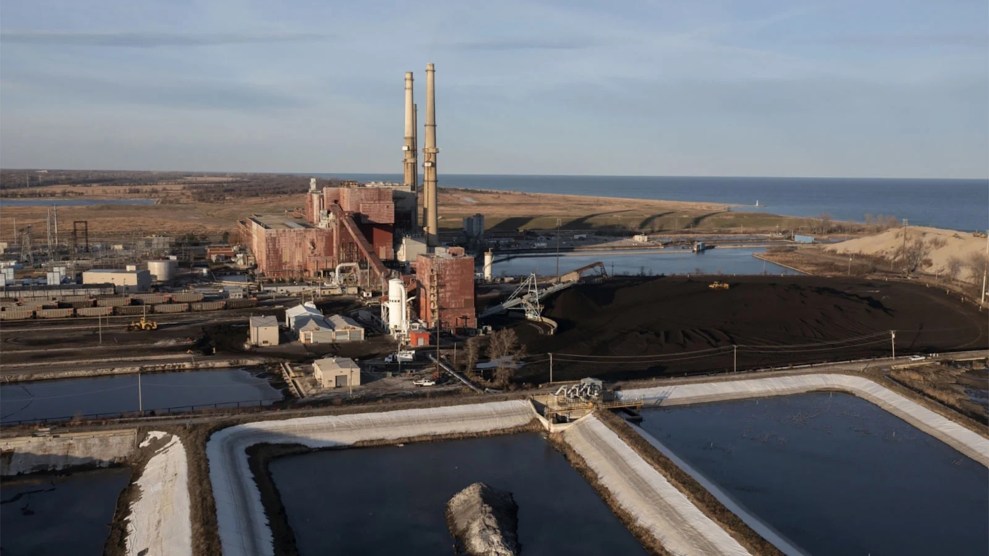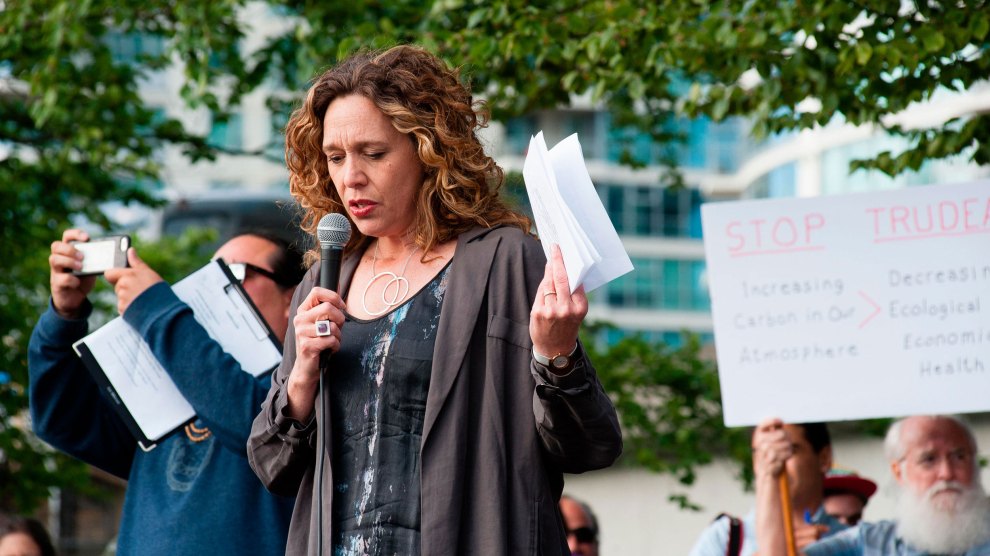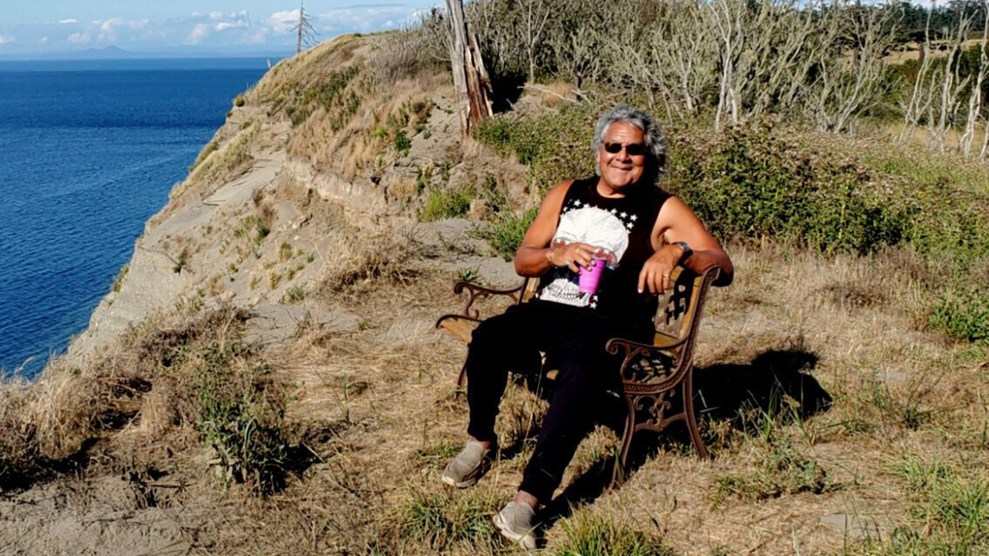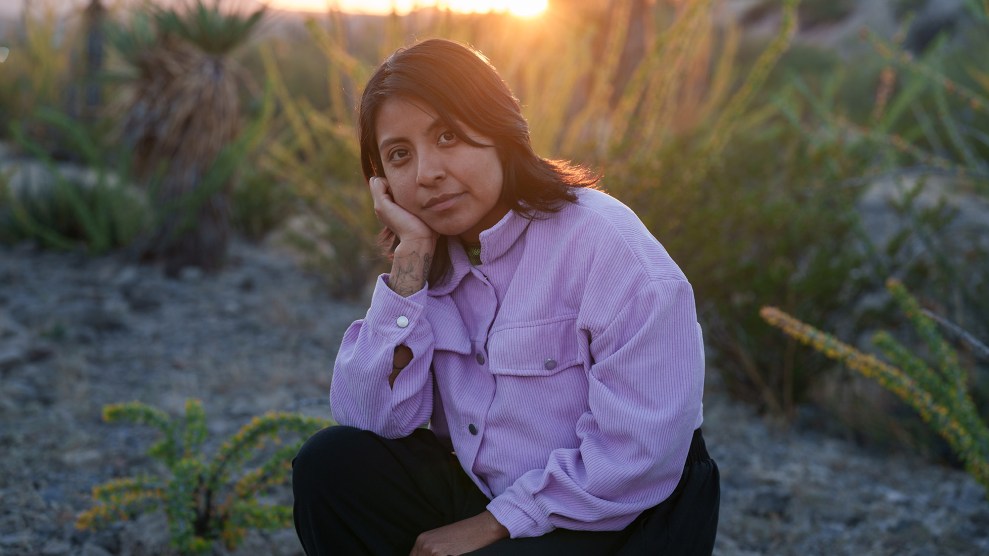
Junior Walk of Coal River Mountain Watch in Naoma, West Virginia, prepares his drone to fly near a reclaimed surface mine in Edwight.
Roger May/The Guardian
This story was originally published by the Guardian and is reproduced here as part of the Climate Desk collaboration.
Coal has stalked Junior Walk his entire life. He remembers his elementary school in the mountainous southern reaches of West Virginia being caked in coal dust, and the representatives from the nearby mine showing up to hand them out mollifying squeezable toys in the shape of lumps of coal.
That school was subsequently shuttered and is now wreathed in weeds, a replacement established a few miles away to escape the shadow of the mine. Walk’s childhood home sits a few hundred yards from another mine, Black Eagle, that spectacularly disgorges coal via a conveyer belt into a huge heap by the main road, like a sort of Stygian waterfall.
Walk followed the path of many of his peers, as well as his father and grandfather, by working for the coal industry in its Appalachian heartland, doing jobs in security and maintenance. But as he saw the black rocks being clawed from the guts of the mountains and thought of the local people being sickened by this work, Walk began to see coal as an implacable foe.
“People are getting exploited, people are getting poisoned, people are losing their lives to the activities of this coal industry,” said Walk. “I’ve seen friends and neighbors getting sick and dying of cancer and heart disease and having babies with birth defects.”
Since he was 19 years old, Walk, who is now 33, has risked the wrath of his community by actively campaigning against coal, firstly through direct protest action and, more recently, in more novel ways. Standing as a lonely opponent of an industry that still holds the region in a tight grip, Walk is now fixated upon the destruction of his nemesis. “My ultimate hope is to shut down the coal industry,” he said. “In order to get anything else new here, you’ve got to burn it down first.”
He has a perfect weapon to do this: a drone.
Most days, Walk fires up a small four rotor drone which he flies over the coalmining operations that dot the undulating landscape that hugs the Big Coal River, with a string of small, struggling towns in a valley that stretches out about an hour’s drive south of Charleston, the state capitol.
Walk’s aim is to document environmental violations on video, using a drone that completes soaring flights over mountains that are normally covered in lush forest but have been punctuated with mines that more resemble crumpled grey moonscapes. Occasional booms can be heard, the sound of explosions that decapitate the summits of the mountains to get to the coal within, a type of mining Walk considers particularly violent and ecologically ruinous.
Since 2015, the small non-profit Walk works for, Coal River Mountain Watch, named after one of the mountains in the midst of this, has lodged dozens of complaints with state regulators with evidence garnered from what he’s captured on drone footage.
Sometimes Walk sees waterways blackened by mining debris, other times leaks in sludgy ponds meant to contain the industry’s waste. On one occasion Walk said he saw boulders the size of cars, formed by machines slicing into the side of a mountain for coal, perched perilously over a public road. “I sometimes get footage of huge plumes of blasting dust that some people just think is fake, like I work for Industrial Light & Magic or something,” he said.
This work has resulted in a handful of fines being imposed upon mining operations, not sufficient to challenge the industry’s dominance but enough to act as a thorn in its side, an insurgent guerrilla campaign in the mountains of an otherwise pacified state. “I just want to do anything to be a pain in the ass to the coal industry,” Walk said. “Anything that can cost them a dollar, because the only thing these people care about is the money in their pockets. Our community is expendable to them.”
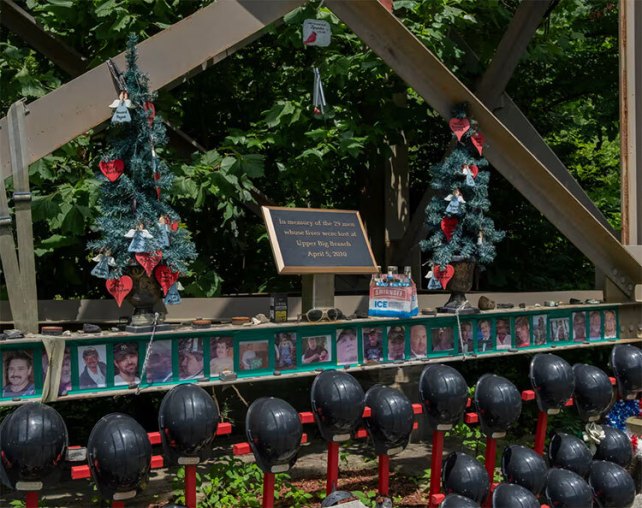
A memorial honoring the 29 miners killed in the 2010 Upper Big Branch mine explosion in Montcoal, West Virginia.
Roger May/The Guardian
Walk’s videos can act as a “starting point” to investigations by the West Virginia department of environmental protection, an agency spokeswoman said. Some coal companies in the region are serial offenders—the Lexington Coal Company, for example, has committed more than 430 violations since 2015. The state regulator “strives to ensure that all sites permitted by the agency are permitted and inspected in accordance with the applicable state code and federal regulations,” the spokeswoman added.
Inevitably, there has been a backlash to this work. Walk—who has a beard that would be at home in a Tolkien novel, wears army green and chugs sweet tea from a large can—is a recognizable local character. His iconoclastic campaign against coal has, he said, resulted in his car brakes being cut and even him being shot at.
At one point, as we drove through one slate-grey mining site, Walk saw some company employees ahead and did a swift U-turn, while offering advice on how to shelter behind a car wheel during a gunfight as we retreated. He previously used a four-wheel ATV to conduct the drone work and has sped away from security guards he feared could kill him and dump his body in one of the holding pits containing syrupy mining slurry.
“I don’t have a lot of friends around here,” Walk admitted. His father, who is now ill with what Walk calls “prep plant shakes”—a Parkinson’s-like condition allegedly spawned by his work in a coal preparation plant—is supportive but has faced fury from colleagues over his son’s activities.
It hasn’t helped Walk’s popularity that he’s seen as transgressive in other ways—he’s an atheist in a deeply religious area and he despises Donald Trump, who won West Virginia by a thumping margin in the 2020 election, to the extent he turned up to a rally of the former president with a “Fuck Trump” sign, prompting a volley of threats.
For a while Walk was a vegetarian, which upset his mother more than his anti-mining work or his sexuality. He is also, as he puts it, “a big old queer.”
“It was easy for me to make the leap to do this work because I was already somewhat a pariah in the community,” said Walk. “I already had a reputation as being different, being weird. I didn’t give a shit what people thought of me.”
Walk still faces a torrent of abuse and threats, mainly via his group’s Facebook page, but he insists he isn’t intimidated and would reluctantly defend himself if needed. “I have the means to and am willing to defend myself if it comes to that, but I sure hope it never does,” he said.
“I might be a faggot, but I ain’t no bitch. I will split somebody’s head open like a watermelon if I have to. I’d rather not, because as soon as I shot somebody to save my life, they’d bury me under the jail.”
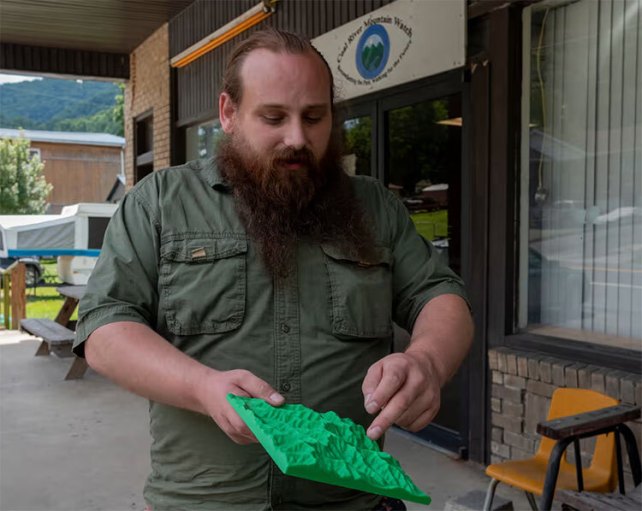
Walk points out Coal River Mountain on a 3-D model.
Roger May/The Guardian
Walk’s work may be occasionally risky but it’s an “important part of making sure coal companies aren’t breaking the law,” according to Erin Savage, who works on coal issues at Appalachian Voices, an environmental group. “Using a drone helps avoid trespassing issues and allows Junior to see areas of a mine that would not otherwise be publicly accessible.”
Savage points out there aren’t many groups like Coal River Mountain Watch, founded in 1998 and for a time spearheaded by Julia Bonds, an award-winning activist against mountaintop removal who was Walk’s mentor. The David to the coal industry’s Goliath, the non-profit’s base is a squat, nondescript building in the small town of Naoma, from where it seeks to educate anyone who will listen about the industry’s ills.
Posters on the wall warn of the dangers of mining operations perched above valley towns, or valorize key moments in local history, such as 1921’s so-called Battle of Blair Mountain, where 10,000 striking coalminers conducted an armed battle against police and strikebreakers in the largest armed uprising since the American civil war. A few miles down the road is a shrine of photos, stuffed toys and black miner’s helmets, a memorial to the 2010 Upper Big Branch mining disaster, when 29 people were killed in an explosion.
Just four people work at Coal River Mountain Watch, including Walk, and the pugnacious but often ramshackle effort to oppose coal lacks the supportive heft of a major national green group or climate progressives in Joe Biden’s administration, who are far more comfortable talking about the boon of wind and solar jobs rather than calling for the elimination of coal ones.
Walk is disdainful of the in-vogue mantra of a “just transition” to clean energy jobs for people in his community, who are, studies show, at increased risk of diseases of the heart, kidney and lung, as well as other conditions such as asthma, from living amid the air and groundwater pollution of coalmining projects. Coal is also the dirtiest of fossil fuels, supercharging the global heating that has spurred the astronomical temperatures that have scorched the US and elsewhere this summer.
“They want to hem and haw about a just transition, to me that’s just an excuse for inaction,” said Walk, who is unsentimental about the popular image of the put-upon, toiling coalminer that Trump tapped into during his 2016 presidential run, when, during a rally, he donned a helmet and mimed using a shovel.
“People are getting sick and dying because of this activity. What comes after that isn’t up to me, it’s not my problem. I don’t care. These people hitched their wagon to a dying coal industry, they can be out of work for all I give a shit.”
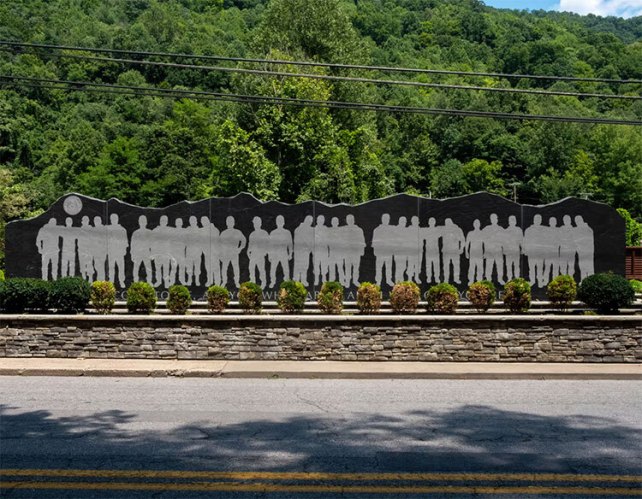
Another view of the Montcoal miners memorial.
Roger May/The Guardian
The industry might dispute the idea that it is dying, but it is certainly in decline. Coal was discovered in what is now West Virginia in 1741, with white settlers striking upon seemingly endless seams of the bituminous rocks that streaked the entire state. As industrialization took hold, coal became America’s blackened backbone—it provided electricity for street lights, steel for cars and wartime tanks, the heat for kitchen stoves. It created, for a time, boomtowns in West Virginia that are still the talk of older locals.
Much of that has now gone. West Virginia produces about half the coal it did in 2001, with the coal industry, nationally, now employing fewer people than Arby’s. The advent of mechanization, which requires fewer coal workers, and fracked gas, which has displaced coal as the fuel of choice for power grids, has left behind hollowed-out towns, marred by addiction and tumbledown buildings.
The state’s Republican leadership has, however, refused to countenance a shift to fresh opportunities, such as renewable energy or even to capitalize upon West Virginia’s rugged natural beauty by tempting remote workers from major cities—the state’s rural heartland has a chronic lack of broadband internet.
“I owe my life to this right here,” said Jim Justice, West Virginia’s governor, in March as he brandished a lump of coal, before signing the latest in a series of bills aimed at propping up the ailing industry. Justice, who made a fortune from his own coal interests, considers mulling a future without coal as “frivolous” and has sought to rescue struggling coal plants and force utilities to retain it as a fuel source.
“Coal is such a source of pride and identity but the state’s political leaders are in denial about the need to transition from it, it’s a massive failure of leadership,” said James Van Nostrand, an expert in energy and sustainable development, who recently departed West Virginia University.
“Coal is being crushed by overwhelming market forces but the state has just doubled down on it. It’s the classic resource curse—the counties in the state with mining are the poorest. There is no opportunities, people are trapped because their rotting houses are worth almost nothing, the conditions are awful. Coal companies scar the landscape and taxpayers pay to clean it up. It’s shameful.”
For Walk, the fight to change the entrenched status quo can sometimes feel futile. He did once dream of going to art school, of leaving this place as many young people aim to do. But he’s now resigned to continue tangling with coal for the remainder of his days.
“I can’t give up,” he said. “They’ve already pretty much won. They can do whatever the hell they want, but I’m still alive. I’m still breathing, and so I’m going to cost them as much money as I humanly can while I’m still on this earth. Because I’m right and they’re wrong.”

